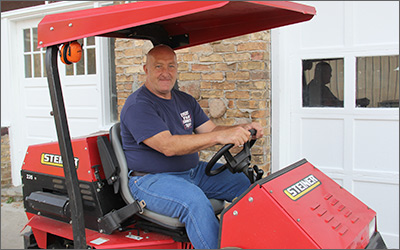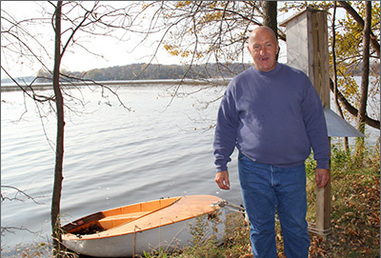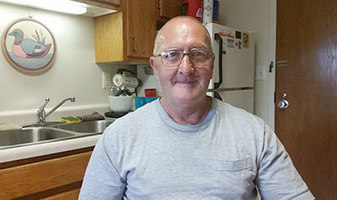
Part 1:
Fifty-three-year-old Jon hit rock bottom on Wednesday, February 6, 2013.
That day, Jon was an alcoholic with depression and bipolar disorder who worked and lived out of the side room of a car wash. The owners of the car wash had taken Jon in and were paying him $25 per day under the table.
Prior to living at the car wash, Jon had been homeless for 13 months. During that time, he’d slept on the streets and at the Salvation Army’s Harbor Light Center. When the car wash owners offered Jon a job and a place to stay, he was grateful and thought they were his friends. Eventually, he realized that they were taking advantage of him. He also realized that he didn’t know where else to go or what else to do.
Feeling hopeless, Jon crafted a plan to commit suicide by hanging himself from a rope under the Hennepin Avenue Bridge.
On February 6, Jon set the wheels of his plan in motion. He left the car wash with a rope. Then he hit several bars in downtown Minneapolis. He ordered one screwdriver after another. “I didn’t want to feel any pain while I was hanging myself,” he explained.
Jon was drinking at a pub on Nicollet Avenue, when he finally felt ready. He left the pub with his rope and began trudging toward the bridge. “Suddenly, it was like a flash,” Jon said. In his head he heard these words: “Don’t do it. Get help.”
Jon returned to the pub and called the Nancy Page Crisis Residence. They sent a cab to pick him up.
Over the next week, Jon experienced horrendous detox symptoms, including intense flashes of heat and cold. The symptoms became so debilitating that the staff sent him toHennepin County Medical Center. When he was released a few days later, Jon stopped by the same pub on the way back to Nancy Page and drank eight more screwdrivers.
“When I came back intoxicated, the staff chewed me out,” Jon recalls, but that was the turning point. “I’m just killing myself,” he realized. After that, he resolved to “stay put” and let the experts dictate his next step — a 90-day stay at the Huss Center for Recovery.
Like Nancy Page, Huss is owned by People Incorporated. Located at 2120 Park Avenue, in Minneapolis’ Ventura Village neighborhood, the center serves adult men and women with co-occurring chemical dependency and mental illness. The program offers an array of services, including inpatient, intensive outpatient, and continuing care.
Huss was not Jon’s first inpatient chemical dependency treatment — in 1996, he completed a 21-day program in Pine County, Minnesota — but the difference was that the treatment at Huss was tailored to people with co-occurring disorders. “[Before Huss], I didn’t realize the link between chemical dependency and mental illness,” Jon said. In fact, prior to Nancy Page, Jon didn’t even know that he had depression and bipolar disorder. Incorporating chemical dependency and mental illness treatment changed everything.
Mission Lodge
Although parts of his past are blurry, Jon can recall dates with startling precision. “I was at Huss from Friday, February 15, 2013 to Thursday, May 16, 2013,” he says, pulling a certificate of completion out of a folder.
It’s a Friday in late October, and Jon is seated in the dining room of Mission Lodge, a residential center in Plymouth for men and women with chronic chemical dependency. The dining room is adorned with Halloween decorations and out the window Medicine Lake is visible through the foliage.
Jon has lived at Mission Lodge since he graduated from Huss.
“[People Incorporated and Hennepin Health] have got my back every which way,” Jon says. Opening his wallet, he extracts a pile of business cards and spreads them on the table. Etched on the cards are the names of people who’ve contributed to his recovery. They include staff from Nancy Page, Huss, People Incorporated’sAssertive Community Treatment Team, and Hennepin County Medical Center’s Adult Psychiatry Clinic and Downtown Medicine Clinics.
Hennepin Health’s care coordination services have helped Jon navigate the health care system and integrate his medical, behavioral health, and social service needs. Destiny Powell, a community health worker at Hennepin County Medical Center, serves as Jon’s care coordinator.

Clearly, Jon’s recovery has been a team effort.
But it couldn’t have happened without his resolve.
“I’ve made my recovery what it is by getting involved with it and taking it a day at a time,” Jon says.
One thing that’s helped immensely is working out of the Mission Lodge maintenance bay, where he does tasks like mow grass and plow snow.
Jon leaves the dining room and visits the bay to talk to his supervisor, who is retiring that day. He calls the man a role model and someone who has taught him about perseverence.
After Jon exits the bay, he ambles across the grounds of Mission Lodge, passing a gaggle of geese, a garden, and a gazebo covered in vines. Near Medicine Lake, he points out a small boat that he likes to row in his free time.

“[Mission Lodge] is a stepping stone,” Jon says. After he gets out, he hopes to get his high school diploma, get his driver’s license back, and find a job. He’s also interested in becoming a certified peer specialist, a role that someone at People Incorporated told him to consider.
There’s also the issue of family. Jon has three children — a 20-year-old daughter and two sons, ages 22 and 34 — and he hasn’t seen or spoken to them in a few years. Recently, though, the children reached out via email. They’re proud of him and want to reconnect. Jon is just about ready.
“I think I’ll write them a letter,” he says.
Part 2
On Wednesday, January 22, 2015, Jon was offered an apartment at Hamilton Manor, a Minneapolis Public Housing Authority residence in north Minneapolis. When his certified peer specialist from People Inc., took him to visit, Jon was awestruck. “[I thought] oh my God, I’ve never had a place like this,” he recalls. He moved in on January 25.
Soon, Jon reunited with his three children. His daughter was the first to see his apartment.

Jon in September 2014, at Hamilton Manor
Jon also began visiting his mother, his cousin Gretchen, his aunt and uncle in Minneapolis, and his aunt and uncle in Maple Lake. He helps them with housework, like mowing. Both of Jon’s uncles have had strokes and are appreciative of the assistance.
Reconnecting with family has been phenomenal. “The whole time I was out there [at Mission Lodge] I wanted my family,” Jon said. But, “It was something I thought I’d never get back.”
This year, Jon also began speaking to residents at the Huss Center for Recovery. He usually speaks three times per month for one hour each time, to groups of 15 to 25 residents. “I get their attention really fast,” Jon said, of his presentations. “I take pictures of the cars I banged up [while intoxicated] … I bring my criminal record and pass that around in the group … I’m like a big brother [to them.]” Jon’s overriding message: “You just don’t give up.”
Jon also attends support groups himself — a Mental Illness Chemical Dependency group on Mondays, and an Illness Management and Recovery group on Fridays.
In October, Jon plans to start classes at the Volunteers of America Adult High School in Minneapolis. He dropped out of the Roseville Area High School in 1978, just 11 credits shy of graduation, and is eager to earn his diploma. “There are jobs that I can do that require a high school diploma,” said Jon, who is still interested in becoming a certified peer specialist.
Jon reveals that, since February 6, 2013, he’s been back to the site where he contemplated suicide a few times. He finds the area “peaceful.” Yet, he also thinks, “How dumb of me. But I didn’t know at the time that I had anything worth living for.”
